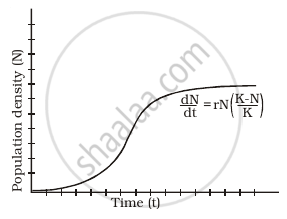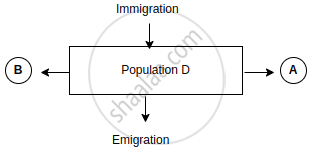Advertisements
Advertisements
प्रश्न
Analyse the main features of Phase-III (1951 - 81) of growth of population in India.
उत्तर १
- The decades 1951-1981 are referred to as the period of population explosion in India, which was caused by a rapid fall in the mortality rate but a high fertility rate of population in the country.
- The average annual growth rate was as high as 2.2 percent.
- It is in this period, after the Independence, that developmental activities were introduced through a centralised planning process and economy started showing up ensuring the improvement of living condition of people at large. Consequently, there was a high natural increase and higher growth rate.
उत्तर २
- The decades 1951-1981 are referred to as the period of population explosion in India, which was caused by a rapid fall in the mortality rate but a high fertility rate of population in the country.
- The average annual growth rate was as high as 2.2 percent.
- It was in this period, after the Independence, that developmental activities were introduced through a centralised planning process and economy started showing up, ensuring the improvement of living condition of people at large. Consequently, there was a high natural increase and higher growth rate.
APPEARS IN
संबंधित प्रश्न
List any three important characteristics of a population and explain.
If 8 individuals in a population of 80 butterflies die in a week, calculate the death rate of the population of butterflies during that period.
Examine the following statement and correct the incorrect one.
Greater economic prosperity indicates the development of a region.
Examine the following statement and correct the incorrect one.
Developing countries have an HDI of 1.
Answer the following question.
Compare, giving reasons, the J-shaped and S-shaped models of population growth of a species.
Identify the correct correlation :
A: Assertion; R: Reasoning
A: In stage 2, the death rate reduces but the birth rate is constant.
R: The population increases rapidly in stage 2.
Write a short note on the correlation between birth rates and death rates.
Assertion: Population of a region does not change.
Reason: Birth rate, death rate and migration affect the population of a region.
India’s population as per 2011 census is:
Which one of the following is not a push factor?
Birth rate and death rate.
How long did the world take to increase its population from 5 billion to 6 billion?
What is population doubling time?
Distinguish between the place of origin and the place of destination.
How did science and technology help in population growth?
What is the trend in growth of population over the years in the world?
Why do people migrate in large numbers from rural to urban areas in India?
The growth of population rate per decade is ______.
The continent that has the highest growth rate of population.
Which one of the following is not a component of population change?
What is the present growth rate of population in the world?
Which of the following is not a push factor for migration?
Which is the most populated country?
Which of these statements is not true?
Which of the following attributes has not been adversely affected by Age and Skill selective migration?

Which is not in stage III?
On the basis of the demographic data of a country given below, construct an age pyramid and explain whether the population is stable, declining or growing.
| Age group | No. of individuals |
| Pre-reproductive | 20,000 |
| Reproductive | 15,000 |
| Post-reproductive | 10,000 |
Ratio between mortality and neutrality is called ______.
Crude Death Rate (CDR):-
The term Crude Birth Rate (CBR) is closest to which of the following?
Which of the following pairs is not correctly matched?
If a population of 50 Paramoecium present in a pool increases to 150 after an hour, what would be the growth rate of population?
What would be the per cent growth or birth rate per individual per hour for the same population mentioned in the previous question (Question 10)?
In 2005, for each of the 14 million people present in a country, 0.028 were born and 0.008 died during the year. Using exponential equation, the number of people present in 2015 is predicted as ______.
What would be the growth rate pattern, when the resources are unlimited?
Comment on the growth curve given below.

A population of Paramoecium caudatum was grown in a culture medium. After 5 days the culture medium became overcrowed with Paramoeium and had depleted nutrients. What will happen to the population and what type of growth curve will the population attain? Draw the growth curve.

Observe the schematic representation given above and answer the following questions:
- Identify A and B.
- Calculate the growth rate of bacteria in a curd sample, where 1 million bacteria increased to two million, within a period of one hour.
When will be the growth of population positive in any place and in which one of the following conditions?
Assertion (A): Population of a region does not change.
Reasoning (R): Birth rate, death rate and migration affect the population of a region.
Which one of the following is the largest linguistic group of India?
A: Population of a region does not change.
R: Birth rate, death rate and migration affect the population of a region.
A : Population of a region does not change.
R : Birth rate, death rate and migration affect the population of a region.
A: The population of a region does not change.
R: Birth rate, death rate and migration affect the population of a region.
Assertion (A): Population of a region does not change.
Reasoning (R): Birth rate, death rate and migration affect the population of a region.
Assertion : Population of a region does not change.
Reasoning : Birth rate, death rate and migration affect the population of a region.
